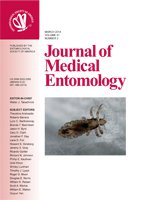The effectiveness of the amides piplartine and piperlonguminine isolated from Piper species for controlling L3 and L4 of Aedes aegypti (L.) was assessed through bioassays at concentrations ranging from 1 to 300 µg/ml. Piplartine reduced the mosquito development period and caused larval mortality only at concentrations >100 µg/ml, whereas piperlonguminine resulted in an extended period of mosquito development (10 µg/ml) and caused 100% larval mortality (30 µg/ml) within 24 h. The toxicity and cytotoxic effects of piperlonguminine on epithelial cells of the digestive system of Ae. aegypti were viewed using transmission electron microscopy, which indicated vacuolization of cytoplasm, mitochondrial swelling and leaking of nuclear material. Piperlonguminine was the more effective amide, showing toxic activity with LD50 of ≈12 µg/ml against the larvae of Ae. aegypti.
How to translate text using browser tools
1 March 2014
Cytotoxicity of Piperamides Towards Aedes aegypti (Diptera: Culicidae)
Marise Maleck,
Bruna Ferreira,
Jacenir Mallet,
Anthony Guimarães,
Massuo Kato
ACCESS THE FULL ARTICLE
It is not available for individual sale.
This article is only available to subscribers.
It is not available for individual sale.
It is not available for individual sale.

Journal of Medical Entomology
Vol. 51 • No. 2
March 2014
Vol. 51 • No. 2
March 2014
Culicidae
cytotoxicity
larvicide
piperamide




